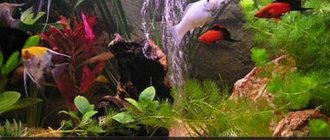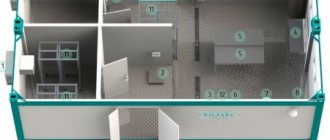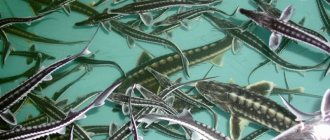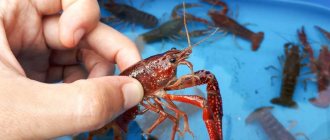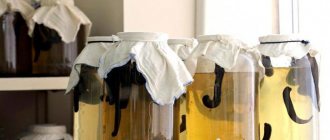Types of fish
Breeding fish at home is considered a difficult issue that requires experience and knowledge. To breed rare and finicky pets, you will need to create special conditions so that the fish begin to reproduce. The final result of breeding pets depends on how prepared the aquarist is.
Aquarium fish according to the method of reproduction are divided into two categories:
- Spawning phenotypes.
- Viviparous fish (viviparous fish).
Egg-laying representatives reproduce as follows:
- The female lays a certain number of eggs.
- At the same time, the male fertilizes the laid eggs.
It should be noted that some of the eggs laid by the female remain unfertilized. The incubation period lasts an average of 36 hours, but during this time the future fry are in serious danger: many underwater inhabitants like to feast on caviar. Due to such circumstances, spawning fish have developed ways to protect their offspring: some fish spawn in secluded places, others protect the eggs from enemies, and still others even carry future offspring in their mouths.
In viviparous representatives, fertilization of eggs occurs inside the body of the female, and the fry are born fully formed. The process of fertilization occurs by introducing the seed using the male's gonopodium. The remains of the seed after fertilization do not die, but remain inside and remain viable. Thus, the female can bear offspring several times without the help of a male. Compared to spawning fish, this method of reproduction is the safest. However, it should be said that most livebearers lack parental instinct, which is why parents can eat the offspring.
MAPANIA
My fish appeared like this: I returned from a very long trip and brought with me some exotic plant (in a suitcase, almost without soil...) and at home it began to dry out. We decided that he needed a humidifier. So I started going shopping and looking for something like that. One fine day I went to a pet store, immediately saw a shell humidifier in the window, and while standing in line to buy it, I looked at the various fish in the aquarium. And then I felt so sorry for myself - during my absence, my dog died of old age, and now my dad has a cat, my sister has a cat, my mother has a cat, and I have no one. And when buying my shell, I asked the seller: “How many fish can fit in a three-liter jar?” That’s how I got my first 5 gummies, a compressor and 0.5 kg of small pebbles and some kind of plant. A week later, my mother said that her heart was breaking at the sight of these poor fish in the jar, and the whole family went to get a large aquarium. This is how this whole aquarium epic of trial and error began.
So, if you decide to get fish, then you will need the following equipment:
- The aquarium is at least 70 liters (unless, of course, it is a goldfish in a round aquarium). But professionals say that an aquarium of less than 200 liters is just pampering.
- Cover with lamps (1W per 1 liter of water). The light stays on in the aquarium for no more than 10-12 hours.
- A filter for 100 liters, for an aquarium of 70 liters, and depending on the volume of water.
- Compressor (using only one filter + compressor device can lead to massive death of fish due to lack of oxygen, as they often break, become clogged, etc.)
- Thermometer on a suction cup (the optimal temperature in the aquarium is 25 degrees).
- Heater with thermostat for the winter season.
- A small aquarium of 10-20 liters (you will still want to save the fry or have to treat the fish, but a 3-liter jar is not good for this, because it has a narrow neck, and it is very difficult to get fish out of it).
- 2 nets - large and small (first you rake up the entire herd with a large net, and then choose from it the one you need, with the small one).
As experience shows, you can ignore all this and go another way, but then you will still come back to it.
Installation of an aquarium.
- The aquarium is installed on a flat, dry surface, thick foam rubber or polystyrene is laid under it (ceiling tiles, travel mat, etc.) because if a pebble gets under the glass or the surface is uneven, the glass will easily crack.
- Make sure that the table or shelf on which you will install the aquarium is reliable and can withstand such weight, because it is 80 kg (at 70 liters). Of course, the ideal option is an aquarium cabinet. And it’s secure, and there will be a place to store a large number of necessary things and even more unnecessary ones.
- The aquarium should not be exposed to sunlight, otherwise the water will bloom.
- If you decide to attach a background picture to the aquarium, then it is attached to a damp surface, smoothed with a cloth and secured with tape.
Priming.
- Place 3-4 cm of round stones with a diameter of 1-3 cm on the bottom. They must first be washed to remove sand and dust and baked in the oven to destroy all harmful bacteria.
- It is better not to use colored marble - it makes the water hard and the fish die. But if you want to put it specifically, then before using the marble you need to soak it in water for about a week. The water needs to be changed every day.
- Colored glass (pebbles) is suitable for decoration; quartz is very good.
- Do not overdo it with shells and corals, they also harden the water.
Plants. You can use any, in addition to your choice we recommend cryptocoryne and anubias. When the plants have grown too much, they can be dried and fed to the fish as dry food.
Fish (based on a 100l aquarium). Some fish like peace, others love movement, and it is better to set up an aquarium according to this principle. A fast aquarium with a maximum of 30 fish: 5-7 barbs; 5-7 neons; 5-7 zebrafish (daneshek); 2-3 molynesia; 1-2 ancitrus or catfish.
Philosophical aquarium: 1st option. 1-3 scalars; 2-3 molynesia; 1-2 catfish or ancitrus; 1-2 gouramis or 2-3 swordtails.
Option 2. 2-7 cichlids, but without plants, they will still eat them.
Option 3. 5-7 goldfish. Goldfish love cool water, and ice should be added to the aquarium in the summer. Do not overpopulate the aquarium, remember that all the small fish will eventually grow up, and they will become crowded, and in the future they will begin to die. If you want to breed guppies because of their beautiful multi-colored tails, then breed only them, all other fish will eat them and start eating off the tails.
Starting an aquarium.
- Rinse everything without using chemicals.
- Place the aquarium on the cabinet, placing a gasket under it.
- Lay out the soil, 1/2 of the normal amount of water, install the equipment.
- Pour in the bacteria “Baktozum” or (means for starting an aquarium with a red cap (bacteria) + with a blue cap (removes chlorine from the water and other harmful impurities)).
- After a day, plant the plants. Add water and turn on the equipment.
- After a week we add the fish. You cannot immediately remove fish from the bag. Over the course of an hour, water from the aquarium is gradually added to the vessel with the fish. Then the bag is lowered into the aquarium and tilted, the fish should swim out on its own. It is better to introduce fish gradually 5-7 per week.
- On the first day, do not feed the fish.
!!! The water in the aquarium may turn white, but when the bacterial composition improves, the water will become transparent!!!
Cleaning an aquarium (100 liters):
- do not clean for the first 1.5-2 months;
- Clean the soil once every two weeks, pouring out no more than 1/3 of the aquarium’s water volume at a time;
- the walls from the inside are cleaned with a sponge, or in severe cases with a scraper;
- The lid and filter are washed, it is better to wash the filter more often;
- Do not catch fish when cleaning the aquarium.
Feeding the fish:
- feed once a day when you turn on the light;
- The fish must eat all their food within 3 minutes;
- Fasting day 1 time per week;
- for catfish, before turning off the light, either granules, or boiled beets or shredded cabbage treated with boiling water;
- Tetra, Sera food, frozen bloodworms, otherwise, if you are unlucky, the fish will catch some kind of disease, and you will have to take a long time to treat them or restart the aquarium;
- It is better to underfeed than to overfeed.
Treatment of fish:
- “Fin rot” is common in veil fish;
- must have “Methylene blue” or “Malachite green”;
- when you add medicine and bacteria to the aquarium, you must remove the carbon filter;
- if you carry out treatment in a common aquarium, remove and separately treat plants of the type (elodea, hornwort, cabomba), otherwise they will die;
- after treating the aquarium with medications, bacteria must be added to the water again;
- To recognize the disease, you can turn to the Internet, but the safest thing to do is take a fish in a jar, and go to a pet store.
Good luck with your fish breeding!!!!!
Nadezhda K.
Matching
An important factor in breeding fish in an artificial reservoir is the selection of a pair. The long-awaited fry can be obtained by the only method: placing two fish of the opposite sex together, but for this you must learn to distinguish the sex of the pets. In some phenotypes, sexual differences are clearly expressed, while in others, signs of gender appear only during the mating season. For convenience, experienced aquarists advise beginners to buy 5-6 fish, including both females and males.
For some varieties of fish, the owner chooses the mate, while other types of fish mate only with those they have chosen independently. These types include, for example, discus fish - once they form a pair, the fish will remain faithful to each other. The established pair is determined by the behavior of the pets:
- The fish swim together, staying close.
- The male chases his partner, starting a kind of game.
Quality and hardness of water in the aquarium
Carbonate hardness of water is the main indicator of quality, so before filling the aquarium it is necessary to check its composition, which will help avoid diseases of fish and invertebrates and lead to the normal development of vegetation.
Regular water purification is carried out thanks to the connection of specialized pump devices, the additional function of which is to enrich the liquid with oxygen; in case of reduced hardness, special compounds are added to the water or harmless shellfish are placed.
Breeding spawning species
To breed spawning fish, aquarists use two methods of stimulation:
- Increased feeding of live or frozen food.
- Changes in water composition and temperature.
The choice of method depends on the individual phenotype requirements; some fish species require both methods for stimulation. Once the conditions are right for the fish to breed, you should wait for the telltale signs that the fish are ready to breed.
The beginning of the mating season is determined by the intensity of the color and habits of the fish: the color of the scales becomes rich and bright, the males show aggression and excitability.
Peculiarities of laying eggs of a breeding spawning fish:
- The eggs are laid in the soil, which is located at the bottom of the tank.
- The fish place their eggs in a nest made of bubbles. This method is inherent in labyrinthine phenotypes.
- Dispersal of eggs along the entire perimeter occurs in fish that breed in schools.
- Laying - the type of laying characteristic of angelfish.
Temperature maintenance
Keeping certain types of fish requires maintaining a certain level of temperature; taking into account the compatibility of keeping aquarium fish, it is necessary to select the inhabitants of the same aquarium and, if necessary, place them in different containers.
The general rule concerns the avoidance of sudden changes in water temperature, which often causes diseases in aquatic inhabitants, so it is recommended to equip the aquarium with an internal thermometer and monitor the air temperature in the room where the aquarium is installed.
Breeding viviparous fish
In viviparous aquarium fish, breeding does not take place as often as in egg-laying species. There is no need to stimulate spawning, but it should be noted that the duration of pregnancy is affected by the temperature of the liquid in the reservoir. For example, at a temperature of 25C, a guppy's pregnancy lasts 28 days, and at 32C it lasts 19 days.
Most of the representatives of the viviparous group are able to reproduce in a common tank, however, under these conditions, the number of fry may decrease every day. In an aquarium with other fish, babies are always in danger of being eaten by predators or even by their own parents. In order for pets to reproduce without sad consequences, aquarists use a spawning container or use a chamber trap with a double bottom.
Additional income
Many people, thinking about starting a fish business, ask the question: is it possible to make money by growing aquarium plants? The answer will be definitely positive. After all, a person who decides to have an aquarium at home wants it to look beautiful, and this can be achieved with the help of not only cute fish, but also a variety of algae.
In addition, this business does not require any special initial investments or maintenance costs. Therefore, if you decide to breed aquarium fish, nothing prevents you from allocating a couple of aquariums for plants. However, do not forget that there are many varieties of algae that require different conditions. Therefore, as in the case of fish, before you start breeding them, you need to study the relevant literature. You can also sell algae through pet stores or markets, or directly to customers.
Thus, breeding aquarium plants as a business can be an excellent addition to your business selling fish, because they require much less investment and labor than waterfowl pets, and the income from them is quite good.
General conditions for reproduction
In order to breed fish at home, you will need not only a spawning tank, but also equipment:
- Filters for water purification.
- Compressors.
- Lighting.
- Heater and thermometer for maintaining and heating water.
When breeding, the following rules are observed:
- The aquarium is installed in a place inaccessible to direct sunlight.
- After the fry are born in a common tank, the babies are moved to a separate container.
- The fish breeding pond is maintained by changing the water and checking the functionality of the devices.
Breeding aquatic fish as a business: the financial side of the issue
In order to start such a business, you will need an amount of 150-200 thousand rubles. As for current expenses, they will be about 5-7 thousand rubles per month.
Now let's calculate the expected profit. If we assume that one female is capable of producing up to a hundred fry per year, and the average cost of an adult fish is from 300 to 1000 rubles depending on the species, then your income from just one female fish can reach 25-75 thousand rubles . In this regard, we can say with confidence that the aquarium business is quite profitable and promising.
Possible problems
First attempts to breed fish at home often end in failure, especially for novice aquarists. To get the long-awaited offspring, you need to know about the possible problems that await the owner:
- Overpopulation - an excess of inhabitants in the aquarium leads to the fact that the growth of fry stops and the water becomes polluted.
- Degeneration of the population - when related phenotypes are kept in one tank, degeneration occurs, so pets are periodically resettled to avoid such consequences.
- Improper nutrition often leads to the death of fry. It should be remembered that the food must be crushed, otherwise the fish will not eat and will die of hunger.
- Lack of offspring - sometimes fish do not reproduce even under ideal conditions. This can be caused by damaged gonopodiums in males or older fish that are no longer able to reproduce.
Breeding fish at home is a labor-intensive process that is worth the effort of the aquarist. If you follow the rules and recommendations, you can get a flock of nimble and active fry that will become a source of pride for the owner. In addition, if you wish, you can turn fish farming into a profitable business, which, in addition to joyful moments, will bring a constant income.
Risk factors in fish farming
In addition to the beneficial aspects of the project, it is worth noting its risks. It happens that aquarium fish at the very beginning of breeding die from disease, mutual “hostility,” from old age, or just like that. It is impossible to prepare for such an outcome. Buying expensive breeds for breeding without special knowledge and experience is fraught with unpleasant consequences. Usually the most expensive fish are the most demanding and vulnerable.
As noted above, sending fish by mail is problematic, that is, the breeder’s reference point is local residents and businesses. To avoid wasted purchasing the breeds you like, study the demand. Find out what fish people are talking about and what they offer the most. You can also ask pet stores about the current demand.
Oxidation, purification and water change
The oxidation of the liquid directly depends on the timely cleaning of the aquarium, on the walls and bottom of which waste products of fish and decay of vegetation can accumulate; there are various options to neutralize this factor.
White representatives of the aquatic kingdom are rightfully considered orderlies and cleaners; in addition to them, small organisms that purify water can be bred in the aquarium, and it is important to determine how keeping a comet or labeo aquarium fish will affect the lives of other fish representatives.


